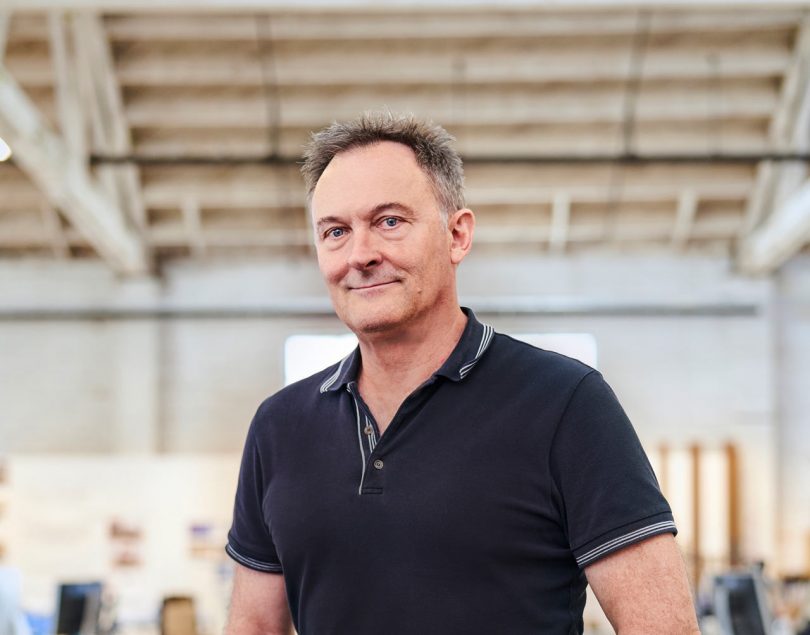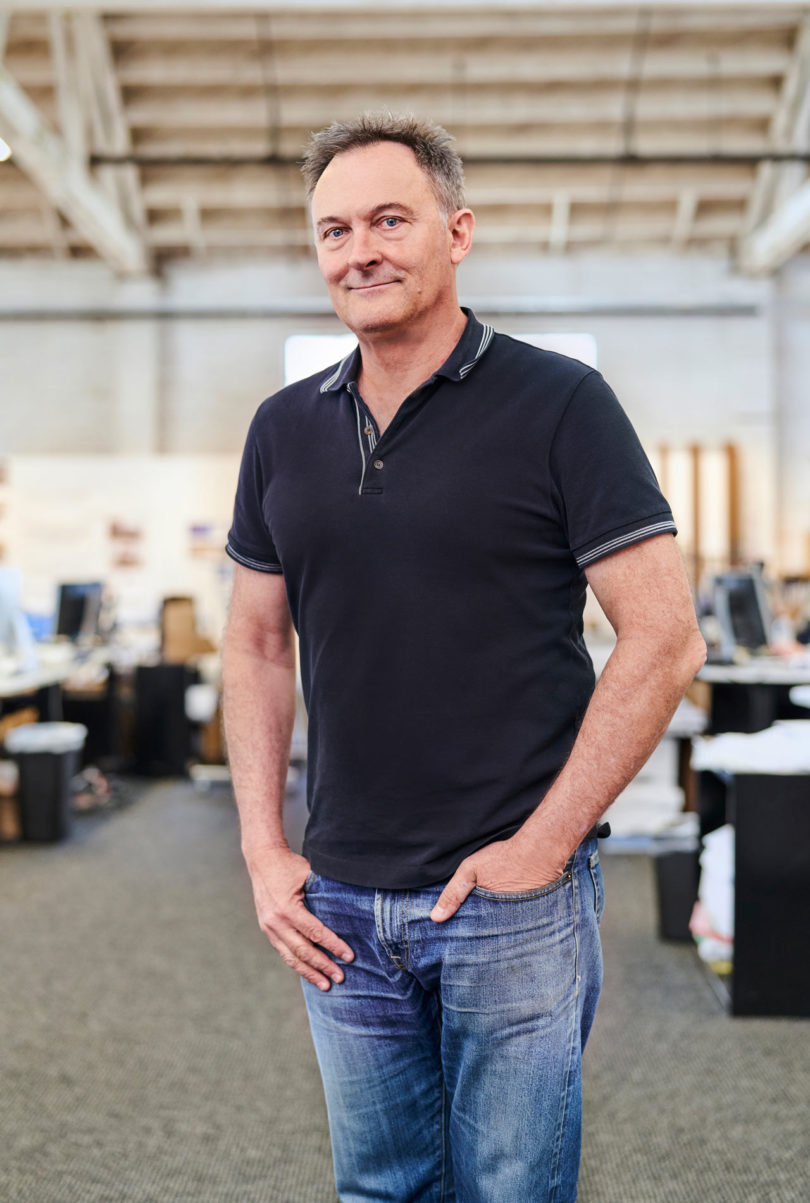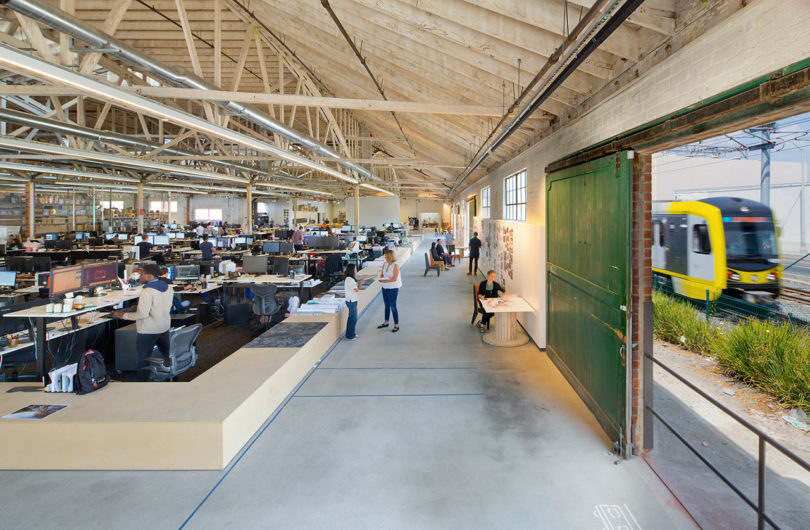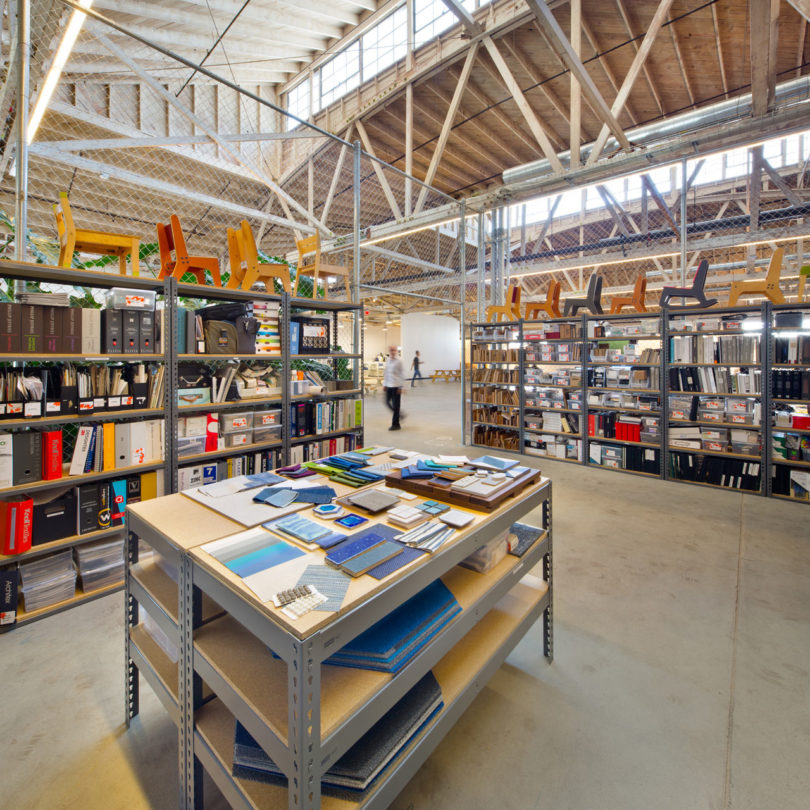Native Angeleno Mark Rios, FAIA, FASLA, is the co-founder and creative director of Los Angeles-based Rios Clementi Hale Studios, a multidisciplinary firm that came together in 2003. After earning his Master of Architecture and Master of Landscape Architecture degrees from Harvard’s Graduate School of Design, Rios formed Rios Associates in 1985, which quickly grew beyond the confines of simply architecture and landscape architecture by integrating interior design, urban planning, product design, graphic design, and branding. Since the 2003 merger, Rios Clementi Hale Studios continues to expand, which landed them in a new 30,000 sq. ft headquarters just under two years ago. This month’s Where I Work lands us in South Los Angeles’ Crenshaw district to check out this relatively new space and to learn more about Rios’ style of work.
What is your typical work style?
It’s unfortunately highly scheduled and programmed. I love being in the office at 7 in the morning when no one is here – I do more creative thinking in that first hour or on the weekend than I do the entire work day. Traffic is also a pretty good thing for me – I’m really productive in traffic.
What’s your studio/work environment like?
Messy – there’s a lot going on, but it’s an organized mess. You’ll find various materials, colors, images, sources of ideas, and inspiration at every glance.
How is your space organized/arranged?
The space is completely open – and my desk right in the middle of it. The Creative Directors generally work in the center of things so that we don’t become isolated. We sit within the major walking circuits, so we’re exposed to as many people and things as possible. Our office is definitely not a place you can hide in – there’s no hiding allowed in my workspace.
How long have you been in this space? Where did you work before that?
We’ve been in this space for a year and a half – it’s been a great experiment! We’re located in a 30,000 sq. ft space in Crenshaw right off the Expo line.
If you could change something about your workspace, what would it be?
Nothing at the moment – it’s the perfect creative workshop. This is the space I’ve dreamed about for 30 years. Our office layout is indicative of our multidisciplinary approach – rather than being seated and siloed by our type of experience – landscape, interiors, graphic design, etc. – our employees operate in multidisciplinary studios to encourage the various perspectives that foster our transdisciplinary approach.
Do you require music in the background? If so, who are some favorites?
My work environment is rarely quiet, but it’s not populated with music – it’s typically filled with creative encounters. The train and the urban sounds are really important because they keep me aware of my place – and duty – to make better urban places.
How do you record ideas?
I record ideas using voice memo, paper, napkin — all of the above. I send myself emails all the time, I do some voice memos, I scribble on anything I can get my hands on, and I often write in other people’s notebooks – I am a multimedia recorder of ideas.
Do you have an inspiration board? What’s on it right now?
I would say that daily life is an inspiration board for me; whether it’s my morning coffee, or it’s looking at the rain, every part of life is an inspiration board. Kyoto is always a part of it – I first went to Japan when I was about 13 years old with a group of kids (without my parents), and I went to all of these beautiful gardens. I was really fascinated by Koi, and I never really got my love of Japan out of my system.
What is your creative process and/or creative workflow like? Does it change every project or do you keep it the same?
The creative process always starts with asking lots of questions. The beginning of any creative process starts with research and provoking new ways of looking at things.
What kind of art/design/objects might you have scattered about the space?
Models of projects, experiments that detail how things go together, scraps of paper and of new products that might be incorporated into a project – a lot of artifacts.
Are there tools and/or machinery in your space?
Yes – low-tech and high-tech come together in our space. On the high-tech side, we have 3D printers, laser cutters, 3D scanners and all sorts of virtual reality and augmented reality technology. On the low-tech front, we have a great woodshop, which is equally important, and includes so many tools including a band saw and a table saw.
What tool(s) do you most enjoy using in the design process?
A fine-point, liquid stylist black pen.
Let’s talk about how you’re wired. Tell us about your tech arsenal/devices.
We’re all wireless basically – or I’m wireless – so I’m working all the time, everywhere.
What design software do you use, if any, and for what?
We use all of the 3D modeling software, from Revit to Rhino to Lumion, as well as everyday things like Photoshop.
Is there a favorite project/piece you’ve worked on?
Right now, I’m really excited about our line of shirts, Guillermo, because it’s the first time we’ve been involved in fashion. While all of my projects are my favorites, there is a curiosity about this fashion line because I’ve never done it before, so that’s really fulfilling and interesting.
Do you feel like you’ve “made it”? What has made you feel like you’ve become successful? At what moment/circumstances? Or what will it take to get there?
I’m never going to feel like I’ve “made it.” In this career, you constantly learn and challenge yourself and set new goals, and hopefully you achieve a few of them. It’s never about feeling like I’ve “made it” or being successful. We’re constantly trying to push ourselves and do things differently, and I’m hoping that everything we’re doing is different than the way we would have done it last year or 5 years ago.
We’ve worked on a number of notable projects in Los Angeles, and seeing our projects firsthand always feels like a significant moment to me. Whenever I see a project or product of ours, it feels like I’m around familiar old friends – these are places that I know, that I’ve thought a lot about, worried about, and that I’ve tried to make better. It’s really rewarding to see the contribution we’re making – and how that contribution is making the city better.
We’ve expanded into other markets and it’s exciting to see our impact in these other cities. What’s significant is that it’s not about getting larger, or making bigger deals, making more money – it’s about learning. I believe in learning all you can about a place — what is the culture, the history, and the problems there? What are the social solutions happening? In every location you design, you must take a crash course and truly understand what they’re about, what their issues are, and what are the opportunities and expectations you can try to deliver to make that place better. At the end of the day, your solution has to be unique to the site and culture, and not the place that you came from. I want to work in a lot of different cultures – not only to have a global practice, but to be a global citizen and to better understand our world and cultures.
What’s on your desk right now?
Lots of design proposals that I’m making notes on – editing and crediting – as well as some photographs of people that I love, some new fabrics of possible future Guillermo attire, and information about travel plans ahead of me to places like Madrid.
Do you have anything in your home that you’ve designed/created?
I’m very lucky to have created my house; that’s one lucky thing about being an architect. It took 30 years to achieve, but I live in a house that I designed. There are a lot of experiments inside those walls – there’s some furniture we’ve designed, and some carpets that we created, and a lot of the experimental prototypes that we do end up in my house.
Tell us about a current project you’re working on. What was the inspiration behind it?
As I mentioned briefly before, I’m currently working on Guillermo, which is our firm’s first foray into fashion. Guillermo is a highly curated collection of men’s shirting centered around the traditional guayabera shirt with some thoughtful updates. Named after my father, a ranchero-turned-surgeon who never faltered from wearing the staple piece, Guillermo was reimagined with the modern creative in mind – a simple silhouette with technical details, including zippers on the shirttails and a concealed iPhone pocket. Combining function with style, Guillermo prides itself on preserving playfulness and poise, authenticity and ingenuity, emblematic of both the guayabera’s inclusive ideology and Rios Clementi Hale Studios’ ethos.
from WordPress https://connorrenwickblog.wordpress.com/2019/06/25/where-i-work-mark-rios/











No comments:
Post a Comment